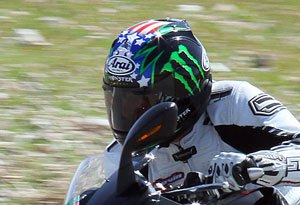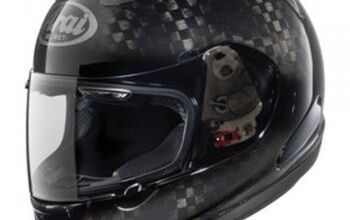2010 Arai Corsair V Helmet Review
You get what you pay for, according to the old saw. And Arai’s latest top-line lid, the Corsair V, only reinforces it.
This is an expensive helmet, but a lofty entry fee guarantees high levels of satisfaction. Arai was awarded the best scores in the recent JD Power helmet survey – for the 12th consecutive year. (See our news story here.)
The Corsair V (that’s Roman for “5”) replaces the well-loved RX-7 Corsair, being thoroughly massaged with improved features while remaining visually very similar.
“The job of a motorcycle helmet has not changed,” comments Michio Arai, the current president and son of the family-owned company’s founder. “So if a design does not help make a helmet better at doing this job, protecting the rider and giving the rider better fit and comfort, we do not do it. Arai is in the helmet business, not the fad or fashion business.”
So the new Corsair looks like the RX-7, but there are important differences. Chief among them are larger entry points in the shell itself.
Arai added strength to the shell’s head opening, now flaring outward instead of in. Increasing structural integrity at the helmet’s bottom lowers its center of gravity. This “Hyper-Ridge” also allows for slightly easier head entry when slipping it on.
The shell’s SNC (Structural Net Composite) construction is enhanced on the Corsair V by what Arai calls “peripheral belting” that strengthens the area across the shell’s forehead region. This recent development from F1 has allowed a 10mm-wider eyeport.
A wider eyeport requires a new faceshield, so we find the wider “Series 1” shield exclusive to the Corsair V. It remains easily detachable as past Arais, but it now fits more flush than ever. Vents in the shield are moved further outward so fresh air is directed near a rider’s temple arteries, not at the forehead, where it more effectively cools a rider.
Replacement shields, like the light-smoke tint seen in these photos, cost about $50. For a high-end lid like the Corsair, a fog-free shield would be a nice perk.
Ventilation is important for comfort, and the Corsair V’s capabilities have been suitably upgraded. It has six intakes and five exhaust ports.
New is the DF-10 diffuser that has “enhanced” air inlets and larger toggles for them and the exhaust vents that draw out stale air from around a rider’s head. The revised middle forehead vent is claimed to route air inside more effectively.
Side-vent exhaust ports at the helmet’s lower rear side sections contribute to exhausting hot air, as does a new vent in the bottom rear of the neck roll, now removable and replaceable.
Another nice advancement, though one we hope to never need, is the Emergency Cheekpad Release System first seen on Arai’s VX-Pro3 dirt helmet. Integrated pull tabs allow the cheekpads to slide out, making helmet removal much easier and with less danger of traumatizing a neck injury.
Ahhhh!
Slipping on the new Corsair V is a luxurious experience. It felt comfortable on my head from the moment its latest-generation Dry-Cool liner (identifiable by it sliver-grey color) met my scalp. The fit from cranium to cheeks from the Corsair’s Intermediate Oval shape is snug but super comfy – like a firm hug from a loved one. Cheekpads in varying thicknesses can be ordered for a custom fit.
The Corsair V sails serenely through the air- even during shoulder checks – thanks to its smooth curves and the addition of a new aerodynamic device Arai calls the AirWing. It’s an adjustable spoiler located between the diffuser’s exhaust vents, and it can be set at any of five hand-adjustable angles for optimal airflow depending on the rider’s orientation.
Deploy maximum wing angle if you’re aboard an upright standard-style bike for a claimed improvement in stability. Or fold it all the way back for minimal drag if you’re ripping some racetrack laps aboard a hunched-over supersport machine. It’s a nifty little gadget worth a minute’s attention at a coffee shop, but I noticed only a nominal difference while riding aboard our Kawasaki Z1000 project bike. Regardless, the Corsair is smooth and stable.
Peripheral vision, where every millimeter counts, is excellent through the helmet’s wider eyeport. Bespectacled riders will appreciate the Corsair lining’s temple-area slots to comfortably accommodate eyeglasses. A snap-closure prevents the chinstrap from flapping in the wind, which became easy enough to do with gloves after some practice.
Ventilation is nothing short of impressive. A scalp can feel when the three forehead vents are switched open individually, especially in the presence of perspiration. And cooling to the crown of the head is boosted when the exhaust vents are clicked open.
The faceshield vents don’t flow much air, but their newly offset position funnel a slight breeze at the temples and help clear moist air from the shield. Airflow through the two-position mouth intake is minimal compared to the air sneaking into the helmet’s main opening below the chin.
Arai boasts of “Noise-Absorbing Ear-Pad Foam,” but wind noise is still loud enough to require earplugs during highway use. The din is slightly increased with the vents fully open.
As per Arai’s typical high standards, the finish of our Corsair V tester is exceptional, with deep paintwork and a thick clear coat to ward off dings.
We came away fully impressed with the Corsair V, and until I try out the new high-end Shoeis, I can say that I don’t yet know of a better place to park a brain than the Arai Corsair V.
The only caveat is retail prices that could make an unemployed shrimp fisherman shudder.
Solid-color Corsair Vs start at a $739.95 MSRP, and extra flash can be had by selecting one of several racer-replica versions that feature bright and colorful designs like our John Hopkins/Monster Energy edition. The RR Corsairs list for $869.95, but Hopkins replicas like ours can be had for just $429.99 from Rider’s Discount. More info can be found at RidersDiscount.com.
Go to AraiAmericas.com to find out more from Arai.
Related Reading
2010 JD Power helmet satisfaction study
2009 Best Helmets
Arai XD Review
Arai Signet GT Review:
Arai Signet/e and NR-2 Reviews
New Nicky Hayden lid by Arai
Arai Offers Joey Dunlop Replicas
More by Kevin Duke

































Comments
Join the conversation